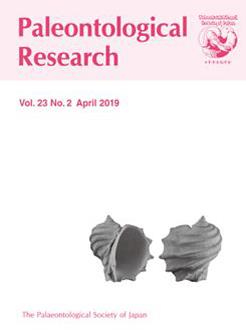The shark fauna of the Upper Cretaceous Hinoshima Formation (Santonian: 86.3–83.6 Ma) of the Himenoura Group (Kamiamakusa, Kumamoto Prefecture, Kyushu, Japan) was investigated based on fossil shark teeth found at five localities: Himedo Park, Kugushima, Wadanohana, Higashiura, and Kotorigoe. A detailed geological survey and taxonomic analysis was undertaken, and the habitat, depositional environment, and associated mollusks of each locality were considered in the context of previous studies. Twenty-three species, 15 genera, 11 families, and 6 orders of fossil sharks are recognized from the localities. This assemblage is more diverse than has previously been reported for Japan, and Lamniformes and Hexanchiformes were abundant. Three categories of shark fauna are recognized: a coastal region (Himedo Park; probably a breeding site), the coast to the open sea (Kugushima and Wadanohana), and bottom-dwelling or near-seafloor fauna (Kugushima, Wadanohana, Higashiura, and Kotorigoe). The shark fauna of the Hinoshima Formation is similar to that of the Yezo and Futaba groups, and also to faunas from Angola, Australia, and Antarctica. However, based on the composition of taxa, the fauna differs from that of the Upper Cretaceous shark fauna of the Western Interior Seaway and Europe. The Upper Cretaceous shark fauna of Japan, including the Hinoshima Formation, contained active pelagic (Squalicorax and Cretoxyrhina mantelli) and bentho-pelagic (e.g. Notidanodon, Chlamydoselachus, Sphenodus) predators. These taxa probably coexisted, as they occupied different ecological niches. The characteristics of the Late Cretaceous shark fauna in Japan are similar to those of the contemporaneous Southern Hemisphere fauna (e.g. Angola, Australia, and Antarctica). This shows that the characteristic shark fauna (e.g. Notidanodon, Chlamydoselachus, Sphenodus) of the Southern Hemisphere had spread to the middle latitudes of the Northern Hemisphere by the Late Cretaceous.
How to translate text using browser tools
8 April 2019
Features and Paleoecological Significance of the Shark Fauna from the Upper Cretaceous Hinoshima Formation, Himenoura Group, Southwest Japan
Naoshi Kitamura
ACCESS THE FULL ARTICLE

Paleontological Research
Vol. 23 • No. 2
April 2019
Vol. 23 • No. 2
April 2019
habitat
Hinoshima Formation
Late Cretaceous
Paleoecology
shark




